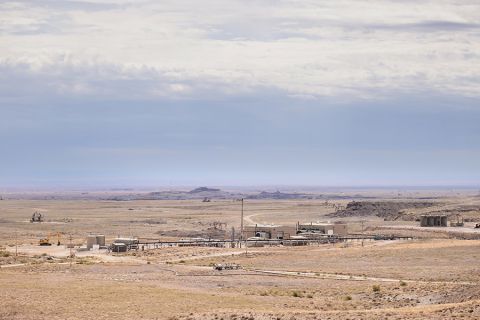 Some E&P acquisitions and organic-growth financings may be delayed until 2008 when natural gas fundamentals are expected to be more amenable. If gas prices rebound in 2008 and oil prices stay high, the investment community could see M&A activity pick up, along with movement by E&P and midstream buyers to raise equity or use debt instruments to spur growth.
Some E&P acquisitions and organic-growth financings may be delayed until 2008 when natural gas fundamentals are expected to be more amenable. If gas prices rebound in 2008 and oil prices stay high, the investment community could see M&A activity pick up, along with movement by E&P and midstream buyers to raise equity or use debt instruments to spur growth. "Softness in the gas market could potentially delay offerings between now and the end of the year," says Patrick Mooney, senior vice president for Capital One Southcoast Inc., based in New Orleans. "Gas forward curves are still low, and that's kind of disappointing compared to what they were a year ago at this time."
At press time, the near-month futures price had dropped to a seven-month low of $5.75 per million Btu.
Prior to joining the firm, Mooney headed a private Texas financial advisory firm and previously was a managing director of Union Pacific Resources in Fort Worth, so he has been seated on both sides of the finance table.
Today, as head of Capital One Southcoast's investment-banking group, he closely follows energy fundamentals and looks for emerging trends in financial markets. Gas prices are one of the factors he watches most.
The group works as a financial intermediary in capital-raising efforts and M&A transactions, and provides other financial advisory services. The bank's primary clients include private and small to midcap public companies.
"In July, the gas 12-month strip was about $7.57 per million Btu, down from $9 in early June. The front-month contract was even worse. The August futures contract for gas at the Henry Hub was $5.84. I like to look at the 12-month strip because I think that is a better gauge of what prices really are," Mooney says.
There is an unusual phenomenon in the gas market this year, he says. "We have an unusually strong oil market relative to the gas market. For example, the relationship of the oil 12-month strip to the gas strip is 9.75-to-1 right now, but it has averaged over the past five years about 6.78-to-1. Oil producers are in high cotton right now relative to gas producers."
Mooney characterizes the gas market as temporarily underperforming, and notes that gas-storage inventory is higher than normal. Also, through early August, the U.S. had not had the kind of hurricane activity seen in the past few years.
Should gas prices rebound and oil prices remain strong, as Mooney expects them to, there should be renewed activity next year in M&A and debt and equity raises. His outlook assumes there will be no significant growth in interest rates.
Meanwhile, Capital One Southcoast has closed some significant oil deals this year. The bank recently co-managed a $100-million registered direct equity financing for an Oklahoma producer. Closed in June, the deal provided growth capital for the producer to accelerate its oil-drilling program.
Registered direct offerings are essentially private placements of publicly registered shares. Unlike a private investment in public equity (PIPE) transaction, publicly registered shares can be traded immediately upon closing. "It's a nice way to market a deal," says Mooney.
Capital One Southcoast also recently completed a PIPE for an emerging micro-cap. With a PIPE, shares that are not yet registered with the SEC are sold to qualified investors, predominately hedge funds. The shares are then registered, and can be publicly sold after a predetermined hold period. PIPES are most popular among smaller-cap companies.
"We worked hard, put that one to bed, and it gave the company sufficient proceeds to prove its business model." The E&P client used the proceeds to extend a well-known U.S. shale play and to develop other U.S. and international areas.
Hedging tools
 Three seasoned banking executives in three major Texas energy cities, backed by one of the largest global financial companies in the world, add up to more than half a century of savvy banking experience in the heart of the oil patch.
Three seasoned banking executives in three major Texas energy cities, backed by one of the largest global financial companies in the world, add up to more than half a century of savvy banking experience in the heart of the oil patch.
The bankers are Citibank's Larry Holden in Dallas, Dale Wilson in Houston and Frank Stowers in Midland. The parent is Citigroup Inc. in New York.
"A trend we're seeing in the E&P industry is higher-cost acquisitions," says Holden, director of energy for Citi in Dallas. With 16 years of energy experience in Dallas, Houston and Midland, he founded the Dallas group in 2001.
"Financing acquisitions in this environment is similar to building a three-layer cake, consisting of equity capital, senior bank debt and some form of second-lien, subordinated or mezzanine financing."
High acquisition costs are a function of high commodity prices creating competition for assets. At present there is a tremendous amount of liquidity flowing into the industry, he says, and producers contemplating deals are looking at low-cost senior debt or higher-cost mezzanine financing.
"We've had a successful year in terms of senior bank debt, and our business is thriving in all three markets. We're probably not getting as many of the new deals as we would like, due to the huge influx of other capital sources available," Holden says.
The market has become extremely competitive on the senior debt side, he says. However, the backing of Citi has allowed Citibank to take its energy banking to new dimensions due to the variety of financial products the bank offers, including global investment banking, hedging and securities investments.
"We've worked a lot of asset sales, and we also are able to help our customers through our Smith Barney channel and Citi private banks. We've got great treasury management, including the remote deposit product that allows customers to make deposits using checks from branch offices anywhere. So that's really allowed us to prosper in an environment that has become much more competitive."
Another trend in energy banking is the increased use of hedging as part of acquisition modeling and execution, says Wilson, senior vice president of energy banking. He opened the Houston office in 2004, and focuses on E&P and midstream companies in Houston, Denver and the Gulf Coast region. His experience includes corporate treasury and risk management for Oklahoma City-based Devon Energy Corp.
"We've seen that many of our Houston clients and prospects are active in acquisitions and most of them use a fairly robust hedging strategy to ensure they can finance the most appropriate amount of debt. Our ability to hedge oil, gas and natural gas liquids and integrate those transactions into an overall financing strategy is a real plus for our clients."
Some of Wilson's clients and prospects have been able to target unconventional-resource plays, which can have higher costs, and are using senior bank debt and aggressively hedging future production.
"Since 1991, the use of hedging has really increased," says Holden. "Our current total portfolio is hedged 60% to 70%. In the 1990s, we saw very little hedging being done."
Acquisition-finance trends are somewhat regionalized, however, according to Stowers, president of Citibank in Midland and Odessa. In 1999, he opened Citibank's Midland oil and gas lending division. He has more than 26 years of experience in lending and other banking products.
"In the Permian Basin, for example, there is not the same level of acquisition activity as in Houston or Dallas. Development activity is primarily the nature of the game here," Stowers says.
"That's true," Holden says of the Midland and Houston markets. "In Dallas we have a good mixture of the two, so the three markets are somewhat different. We also operate on a national level at all three offices, so we have an interesting blend of options that some other banks don't."
From Japan
 In contrast to the mostly onshore opportunities sought by these banks, Tokyo-based Mizuho Corporate Bank is looking for opportunities offshore the U.S.
In contrast to the mostly onshore opportunities sought by these banks, Tokyo-based Mizuho Corporate Bank is looking for opportunities offshore the U.S.
"We do M&A subsidiary bridges for capital to help Japanese investors, mostly account officers in Tokyo, buy U.S. assets," says Michael K. Brown, Mizuho senior vice president, corporate finance, energy, based in Houston. Mizuho opened its Houston office in 2005 with a staff of three, ramped up to a staff of nine, and has more slated to come on board in the next few months.
"Most Japanese acquisitions of U.S. E&P properties to date have been in the Gulf of Mexico, as opposed to onshore, because that is what the bank's clients are interested in-quick investment, fast cash flow, quick payout," Brown says. "Once our clients are comfortable with Gulf of Mexico asset deals, they will eventually move to onshore, long-lived reserves and long-term assets."
In 2006 alone, Japanese companies acquired about $1.8 billion of assets in the Gulf of Mexico from U.S. firms looking to exit, primarily from the shelf. This new wave of overseas investment is due to the Japanese government's new initiative supporting acquisitions of crude oil around the world.
"Though much of our activity with Japanese investors is concentrated on the Gulf of Mexico right now, we are working with our U.S. domestic E&P clients wherever they see opportunities, including the Gulf Coast, West and East Texas, Appalachia, the Rockies and the Midcontinent," he says.
Active in this business for 30 years, Brown knows where the sweet spot is for energy banking. "The sweet spot is energy reserve-based lending. Although we look at both public and private companies, we do look more at the upper end of the independent sector."
Mizuho targets companies with B+ to BB+ credit quality, and looks at deals of $50 million and up. It recently committed $50 million to a revolving credit facility and $15 million to a bridge facility for Houston-based Edge Petroleum Corp., a publicly held independent that is growing by acquisitions and drilling. The two facilities, led by Union Bank of California, helped finance the purchase of oil and gas properties.
"We're here to build our portfolio, focusing on E&P and midstream companies, and also the service and refining sector," says Jacques Azagury, Mizuho senior vice president, corporate finance, "and we have experience with MLP financing as well."
Mizuho opened the Houston office to work big deals, and eventually take a lead role in syndicates involving 10 to 20 banks. "We are generally the lead bank in Japan, and, regarding transactions in the U.S., we hope to be the lead here," Azagury says.
The bank is also active in project finance in the region, and has specialized staff in Houston targeting that.
Mizuho recently was documentation agent for Houston's Enterprise GP Holdings during its purchase of stakes in two publicly traded general-partnership energy companies, Teppco Partners and Energy Transfer Equity, for approximately $2.8 billion.
In 2006, Mizuho was appointed financial advisor to Houston-based Westlake Chemical for its planned Trinidadian petrochemical project, a large facility that will use some 37,500 barrels per day of ethane to produce 570,000 tons per year of ethylene to make polyethylene and other derivatives.
The Mizuho energy practice has other international-finance experience as well. This year, it joined the Japan Bank for International Cooperation and Bank of Tokyo-Mitsubishi UFJ (MUFJ) to lead two credit facilities totaling $3.5 billion for Marubeni and Mitsui, two Japanese trading companies. They are using the proceeds to purchase oil and petroleum products from Venezuela's PDVSA. Mizuho led one credit facility on its own, and co-led the other with MUFJ. Mizuho also was financial advisor for Marubeni and Mitsui during the structuring phase.
In February 2007, Mizuho was the mandated lead arranger and joint book-runner for acquisition financing for Empresa de Energia de Bogota, a utility company, to acquire TGI SA, which owns Empresa Colombiana de Gas, the main state-owned gas transporter in Colombia.
Of course, the deal-making goes both ways. "Anyone in the U.S. who wants to make a purchase or merger in Japan, or anywhere else, we can do that too," says Brown.
Recommended Reading
Baker Hughes Defies Nature with an Upgrade to Ol’ Fashioned Cement
2024-10-15 - Baker Hughes’ InvictaSet uses regenerative capabilities to provide operators with a sustainable cement solution that can last for years.
EY: How AI Can Transform Subsurface Operations
2024-10-10 - The inherent complexity of subsurface data and the need to make swift decisions demands a tailored approach.
Seadrill to Adopt Oil States’ Offshore MPD Technology
2024-09-17 - As part of their collaboration, Seadrill will be adopting Oil States International’s managed pressure drilling integrated riser joints in its offshore drilling operations.
Now, the Uinta: Drillers are Taking Utah’s Oily Stacked Pay Horizontal, at Last
2024-10-04 - Recently unconstrained by new rail capacity, operators are now putting laterals into the oily, western side of this long-producing basin that comes with little associated gas and little water, making it compete with the Permian Basin.
Navigating the Crossroads: Oil, Gas Industry Reimagines its Role in Tech Age
2024-10-28 - The oil and gas industry has both a need and an opportunity to embrace the digital transformation while engaging the next generation of its workforce.
Comments
Add new comment
This conversation is moderated according to Hart Energy community rules. Please read the rules before joining the discussion. If you’re experiencing any technical problems, please contact our customer care team.





